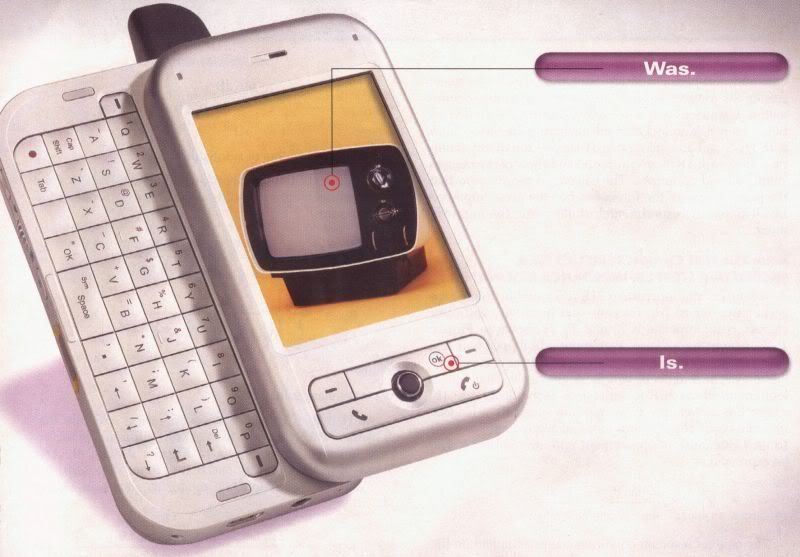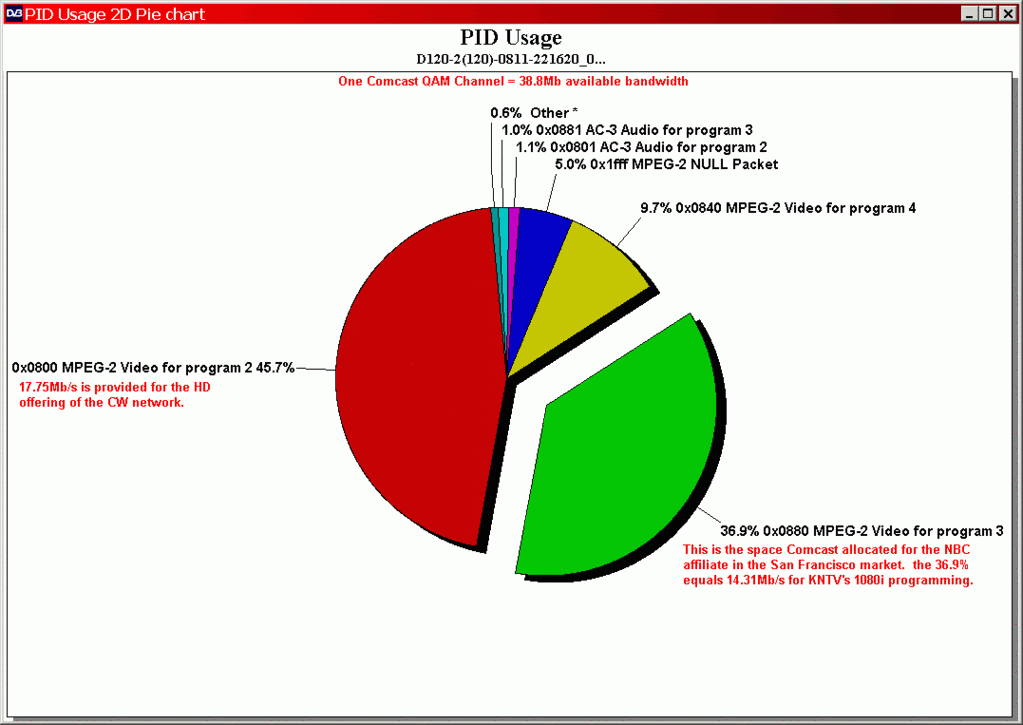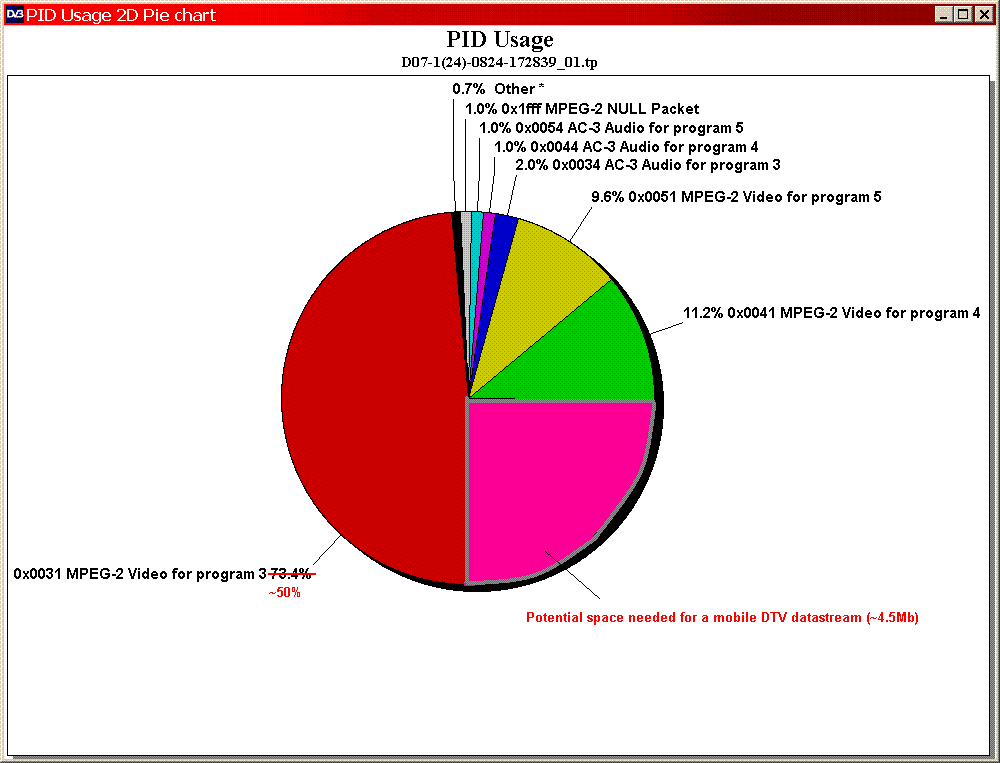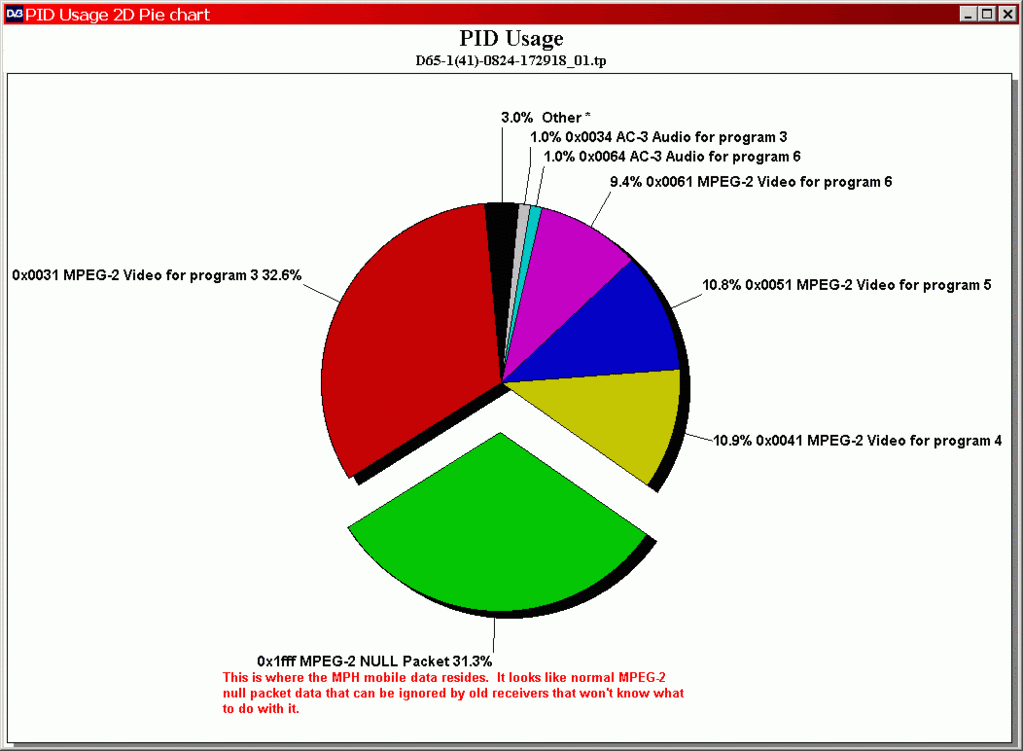Regardless of what some liberal arts students or free-love hippies may tell you, you don’t get something for nothing. Or, better yet, as the redoubtable Robert Heinlein coined, “TANSTAAFL” (There ain’t no such thing as a free lunch). This simple truth frames the cold, hard realities about to face broadcasters after the current mobile DTV trials wrap up. It will weigh even heavier when the mobile standard is finalized and equipment is available for purchase in Q2 (tentatively) of 2009.
When cable companies take a broadcaster’s primary digital signal, either from an over-the-air broadcast or a direct fiber feed, they tend to re-sample it (unless they under an agreement expressly forbidding it), put it on one of their available 38.8Mb capacity QAM channels and share that QAM channel with another digital channel (or two or more!) shaving the channel’s data rate in the process. Some cable companies are more aggressive than others in their re-compressing.
This is a capture of the Comcast QAM channel that I made on August 11th while watching some of the Olympics coverage:
The upshot is that you can usually obtain a better HD picture when using an antenna and capturing the local broadcaster’s transmission. However, that will soon change.
Every DTV broadcaster has maximum throughput of 19.39 megabits per second under the ATSC broadcast standard. If they are using their DTV data pipe to send only one program, typically a simulcast version of their NTSC programming, that means most of those available bits can and will be used for the primary program. Typically for just one program it is broken down thusly: 19.39Mb – 200Kb for PSIP = about 19Mb for the combined primary MPEG-2 program video and AC-3 audio stream (typically some headroom padding for the multiplexer is also provided via null packets which takes a small bit away from the program stream). This doesn’t mean they do it exactly this way, this is just a mathematical example.
If the broadcaster is a CBS or NBC affiliate then they are stuck in the 1080i HD format because that is what the parent network provides and the local station will up-convert or match their studio signal in order to maintain signal format integrity through to the viewer’s set-top box. Changing format resolutions on the fly (e.g. 720p to 1080i to 720p) is a surefire way to crash a DTV receiver/TV/set-top box very quickly.
An encoder set at 1080i really likes to use every bit it can get it’s quantizer on, so if the broadcaster were to squeeze their primary signal down and provide the 4.5Mb to 5Mb needed to accommodate a single mobile DTV stream the encoder quickly becomes “starved for bits”. During scenes of moderate to intense motion, say during Olympic sporting events or an action movie or some weekly sports game, etc. it all goes to hell fast. TANSTAAFL. Something has to give and it will be the quality of the picture.
Here is a graphical example using KGO-DT’s broadcasted datastream that I captured and visualized using TSReader Lite. KGO actually provides quite a bit of data for its primary channel running at 720p and the first chart shows their broadcast illustrating how they have their bitrate pie sliced. The second image is what would likely be leftover for HD (and everything else) if they were to provide a mobile DTV datastream.
Broadcasters in the 720p format, like ABC (above) and FOX affiliates have a bit more leeway. 720p isn’t as bit-hungry as 1080i and is more forgiving when additional streams are muxed in, however they are still not immune to picture degradation when the bit bucket runs dry. Those that really have a license to cram are those DTV stations that are broadcasting digital, but not broadcasting HD (i.e. 720p or 1080i).
This is a capture of the local station in San Francisco currently performing on the air testing with a mobile DTV stream. This station doesn’t broadcast any HD programming so the diminished visual quality isn’t as severe as it would be if this were another station like a major network affiliate.
The bottom line here is that the days of great-looking HD over the air are numbered. The days began counting down when many stations realized they could monetize some of their DTV signal with ancillary channels providing weather information (e.g. NBC’s WeatherPlus and ABC’s AccuWeather NOW) or looped news.
When mobile DTV takes flight the broadcasters will be fighting hard to ensure that any direct feed they have from the studio into the large market cable or FiOS or U-Verse headend (before being squeezed at the transmitter for the mobile stream) is unmolested by the MSO. It is then, in our very near future, the best HD anyone can get will be on the one (maybe two) large MSOs in the market being fed directly by the station’s studio and not over the air or on the smaller, outlying cable companies picking up the station’s OTA DTV signal.
Although I haven’t heard any discussions about it yet, it may not be unrealistic for CBS and NBC to switch from 1080i to 720p HD in order to mitigate the reduced bitrate future they will find themselves in since there is no financial reason or obligation for them to be in one HD format over another.
Because the current broadcast revenue model is broken and the compelling reasons for a broadcaster to provide a mobile digital signal which is reinforced by the sheer number of interested parties in the Open Mobile Video coalition, we can rest assured that mobile DTV is as inevitable as the coming analog shutoff.
Enjoy the gorgeous HD where you can get it and while it lasts.






One comment
Comments are closed.